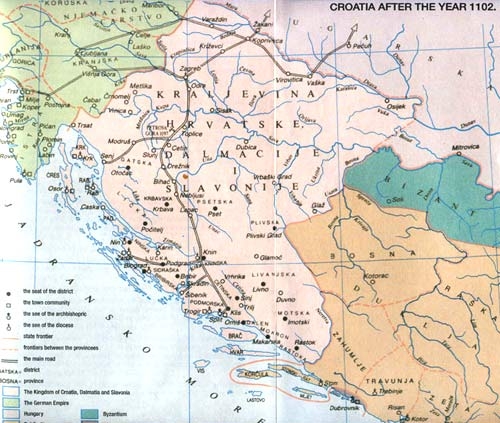Web catalog
Most read
Most read last 7 days
Most Discussed
Top rated
Statistics
- Total registered users: 9864
- Total articles: 23656
- Total comments: 2087
- Last entry: Kebo presenting evidence that Izetbegovic brought mujahideen to Bosnia
- Last update: 11.01.2019. 23:44
Early Medieval Age: Birth of a Region (c. 600 - 1180)

VII. cent. -1463.
The arrival and settling of Slavs in the region of the present-day Bosnia-Herzegovina. During that period, the Slavs have, following the assimilation of Celts, Illyrians and Romans they\\\'ve came across, accepted Christianity and, along with the developement of their own cultural and artistic expression, formed political institutions and, finally, their own state.
The basic features of that period are:
- partial isolation of the whole region from the main cultural and political currents of the epoch, having in consequence a relatively small number of cultural, sacral and secular monuments (with the exception of popular tombstones, known as \\\'stecci\\\' or \\\'dolmeni\\\', numbering tens of thousands and representing a kind of folk artistic heritage).
- the region of present-day Bosnia-Herzegovina was divided into a few separate administrative units (Bosnia, Hum, Travunja, Soli, Usora, Zavrsje, Donji kraji, as well as a large part on the west which was annexed to Bosnia only after the Turkish conquest). During that period Bosnia was only a "small land" (to horion), making no more than 30% of contemporary Bosnia-Herzegovina. On its territorial acme, during the reign of the Kotromanic dynasty, the region of Bosnian kingdom comprised about 70% of today\\\'s BiH (however, considerable parts of Montenegro and Croatia were temporarily included within expanded borders).
- the population was Slavic, their ethnical and religious characteristics belonging to the same ethnical substratum as the Croats. Besides the very remembrance of the Croatian name, this can be seen in numerous ethno-cultural marks, such as the language (Chakavism and Stokavian Ikavism, and Western Ijekavism- all of them being the features of Croatian language), Glagolitic and Western-Cyrillic scripts (so called \\\'bosancica\\\' or Croatian script) in which manuscripts and works of religious and artistic substance have been written, and which is identical to Croatian Cyrillic used in Dalmatia and northern Croatia coast. Furthermore, Croatia\\\'s belonging to the Western civilization circle was manifested in Western Catholic Christianity (Croatian Dalmatia and Bosnia have been put under the same confessional jurisdiction --either Split or Dubrovnik diocese), and artistical forms of Western (Romanesque) provenance. Politically, the major part of contemporary Bosnia-Herzegovina has belonged to the Croatian state (except for short intervals, as in time of Serbian prefect Caslav Klonimirovic)- either in the times of Croatian national rulers Trpimirovics (9.-11.cent.), or as a part of Croatian-Hungarian kingdom. A symbol of political connections between Croatia and Bosnia is the title of "banus", which was, as an exclusively Croatian ruler\\\'s title, carried by Bosnian lords since ancient times. All Bosnian kings were Catholics, and often (but not always) they can be found in the genealogy of Croatian dynasties. The cultural currents, especially during the last 150 years of pre-Ottoman Bosnia, have made these features more and more prominent, so that the most important works of Bosnian art and literacy (Hrvoje\\\'s Missal and the Manuscript of Krstyanin Hval) originated in Split (as did the other religious texts ordered by Split\\\'s \\\'Herceg\\\' and Bosnian Duke Hrvoje Vukcic Hrvatinic--the "uncrowned king of Bosnia") and Romanesque bell-tower and portal in Jajce.
- with all this said above, a few remarks should be added:
the eastern regions of today\\\'s Bosnia-Herzegovina, first of all Podrinje, Hum and Travunja (which approximately corresponds to eastern Herzegovina and a part of Montenegro), have since 12th century become in a great measure Orthodox (Podrinje was Orthodox even before). By assimilation of Orthodox Wallachians, the influence the Serbian state and culture has expanded on this part of the country. This was especially manifested after the conquest of this region by the first Bosnian king Tvrtko Kotromanic who has taken into his service the Serbian scriveners. Although the center of his political and cultural aspirations has stayed bound up with Croatian-Catholic West (Tvrtko himself has been and remained a Catholic), a definite number of Byzantine and Serbian civilization marks is visible on his court.
-also, a Bosnian "peculiarity" is the heresy of Bosnian \\\'Krstyani\\\', regarded by former scientific researchers as the branch of dualistic-gnostic sect having originated from Bulgarian Bogumils. However, according to the generally accepted newer scientific cognitions, this sect can be traced to the Western Christianity of early medieval
period, characterized by undeveloped Catholic theology and iconography
(plus some organizational elements taken over from Orthodox monasticism). The \\\'Krstyani\\\' originated and persisted due to relative isolation of Bosnian lands. This local church (which numbered, at least nominally, among its adherents prominent Bosnian aristocrats like Duke Hrvoje) has never been the majority denomination, nor has formed religious organization on the state level. Having been diminished by the aggressive missionary work of Dominicans and, especially, Franciscans, the remnant of \\\'Krstyani\\\' was swept into the vortex of Turkish invasion.
The population of Bosnia on the eve of Ottoman conquest, according to certain estimates, was of the following composition:
850,000-900,000 inhabitants in total
Ethnical Serbs, mostly in Podrinje, about 25,000.
Ortodox Wallachians in Duklja and Travunja, about 30,000.
Croats-Catholics about 750,000
Croats-Krstyani about 80,000
864-876
The Duke Domagoj, "the severest" Croats\\\' duke (pessimus Sclavorum dux), as described by Venetian chronicler Ioannis, rules over the parts known today as southern Dalmatia and lower Herzegovina. He waged naval warfare against Venetians and Arabs around the Italian city of Bari cca. 871. It was the Byzantine Empire that (probably) stood behind a conspiracy to overthrow him. However, Domagoj, having discovered the conspiracy, drastically punished the conspirators, executing them all, including the conspirator-turned-informer.
910-928
Croatian King Tomislav routed Hungarians and pushed them across the Drava river. Also, he defeated Bulgarians and protected Serbs from the Bulgarian yoke (926.). Tomislav rules over the greater part of what is now Bosnia and Herzegovina, a fact unwillingly accepted even by Serbian historians: "..During the first half of the X century until the 30ies, political boundary of the Croatian kingdom was, in all probability, drawn across mountain wreath comprising of the mountains Zelengora, Lelija, Treskavica, Jahorina, Romanija, Ozren i Zvijezda (essentially, this is deeply into the eastern part of contemporary Bosnia and Herzegovina)"
Relja Novakovic: On some questions with regard to the boundaries of Serbia, Croatia and Bosnia in the X century, Annals of the Belgrade Philosophical Faculty, VII/1, 1963, p. 178
X-XI
In Humac, a village in the vicinity of the Herzegovinian town Ljubuski, St. Michael\\\'s church was built and a stone tablet positioned within the church. The tablet, known as the Humac tablet, is the oldest monument of Croatian (and, generally, any Slavonic) literacy on the soil of Bosnia and Herzegovina. Written in Bosnian/Croatian Cyrillic, with a few Glagolitic letters, it is now preserved in the museum of Franciscan monastery in Humac.
1137.
Bosnia was joined to Hungary. From that time, the Croatian-Hungarian kings held the title "rex Ramae" (tributary to Neretva), which meant Bosnia. It then became a special dukedom (ducatus) of Bela\\\'s son Ladislav.
1154.-1163.
Banus (the governor) Boric, a Croat from Grabarje area nearby Slavonski Brod, and a descendant from Berislavici Graberski familiy, is mentioned in Bosnia. His descendants are thought to be Bosnian bans and kings Kotromanici. During his time, Bosnia gains a kind of an autonomy within the borders of the Croat-Hungarian state.
1164.-1167.
Bosnia subdued to Byzantium.
1165.-1204
Ban Kulin reigned in Bosnia. He was the founder of the Bosnian ruling family Kotromanic. He established the ruler\\\'s chancellery, helped Bela III against the Byzantium, living in good relations with his neighbours and the Pope. The people have not forgotten Kulin\\\'s reign. During his reign, the heretical movement of "krstjani" (often mistakenly referred to as Bogumils) spread. He was their protector but later renounced the movement.
Related articles
- Mature Medieval Period: Integration, Expansion and Dissolution (1180 - 1463)
- Ottoman Rule: Invasion, Conquest and Intermittent Warfare (1463 - 1878)
- Austro-Hungarian Rule: Tutorship and Westernization (1878 - 1918)
- Royal Yugoslavia: The Winter of Our Discontent (1918 - 1941)
- World War 2: Heart of Darkness (1941 - 1945)
- Archive of related articles
























































 Kontaktirajte nas
Kontaktirajte nas
No comments